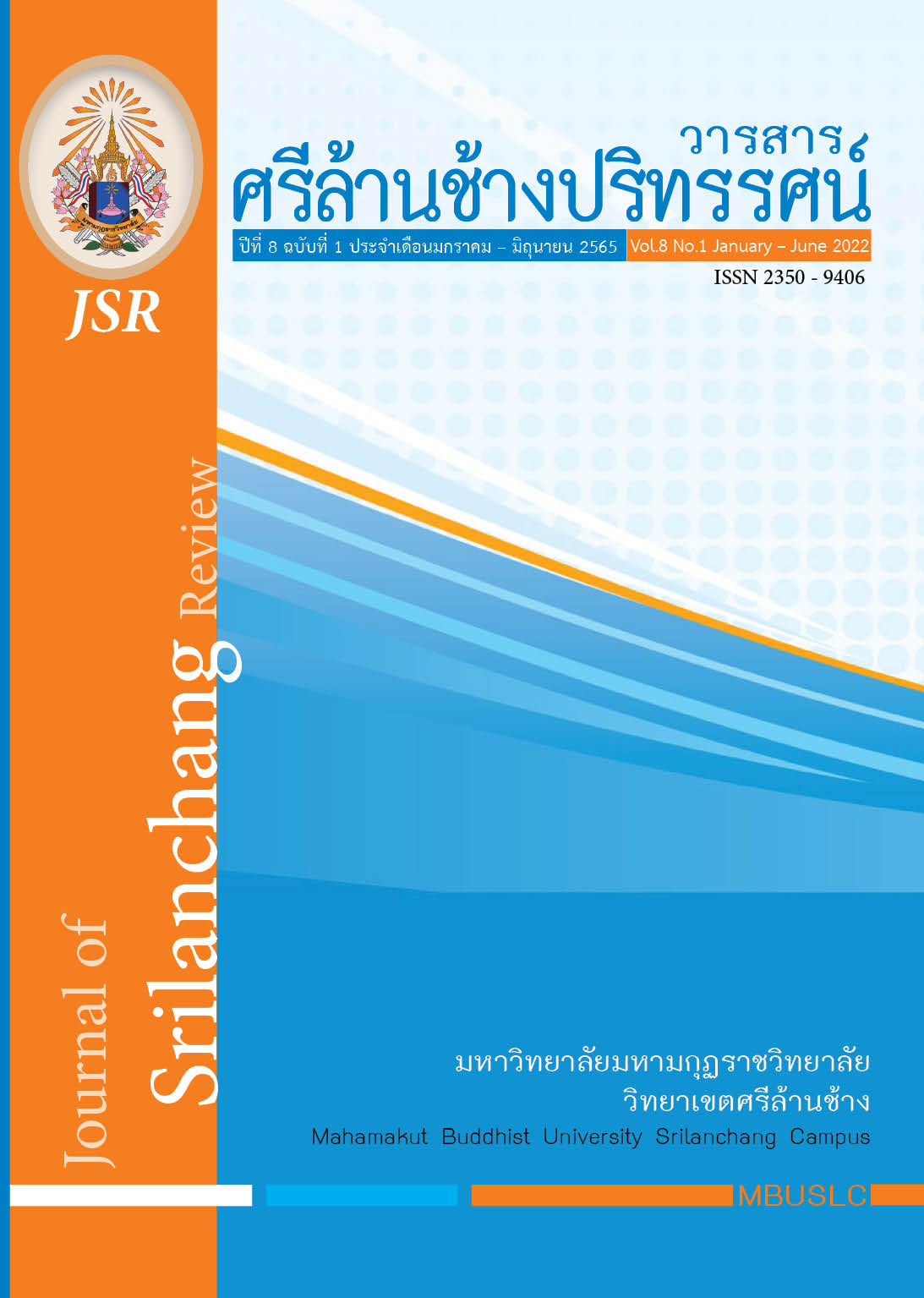การใช้สื่อและเครื่องมือในการเผยแผ่ธรรมของพระราชวชิรสุธี (สุพัฒน์ สุวฑฺฒโน)
Main Article Content
บทคัดย่อ
บทความวิชาการเรื่องนี้มีวัตถุประสงค์เพื่อ 1) ศึกษาการใช้สื่อและเครื่องมือสื่อสารการเผยแผ่ธรรมของพระราชวชิรสุธีที่ปรากฏในสื่อและหนังสือ 2) ศึกษาวิธีการสื่อสารเพื่อให้เกิดประสิทธิผลของพระราชวชิรสุธี และ (3) บูรณาการการใช้เครื่องมือสื่อสารของพระราชวชิรสุธีกับการเรียนการสอนรายวิชา การโค้ชชีวิต และ การปฏิบัติงานตามหลักพุทธศาสตร์ ผลการศึกษาพบว่า 1) การใช้สื่อและเครื่องมือสื่อสารในการเผยแผ่ธรรมของพระราชวชิรสุธีที่ปรากฏในหนังสือที่ท่านประพันธ์ขึ้นมาตามที่ได้เดินทางไปปฏิบัติศาสนากิจหลายจังหวัดในประเทศไทยและในสื่อต่าง ๆ และจากการสัมภาษณ์ ทำให้ทราบว่า พระราชวชิรสุธีดำเนินชีวิตตามแบบอย่างพระภิกษุในประเทศไทย โดยออกบิณฑบาตในเวลาเช้า สวดมนต์ทำวัตรเช้า เทศนาแสดงธรรมในวันพระ ทำวัตรสวดมนต์ในเวลาเย็น และให้โอวาทแก่พระและสามเณรให้ประพฤติปฏิบัติตามสมณสารูป ส่วนประเภทของสื่อและอุปกรณ์สื่อสารที่นำมาใช้ประกอบการเผยแผ่ธรรม พระราชวชิรสุธีใช้สื่อหลากหลายรูปแบบ ได้แก่ (1) สื่อบุคคล (2) สื่อธรรม (3) สื่อสังคมและวัฒนธรรม (4) สื่อธรรมชาติสิ่งแวดล้อม (5) สื่อภาษา (6) สื่ออุปมาอุปมัย (7) สื่อนิทานชาดก (8) สื่อหนังสือ และ (9) สื่อออนไลน์ 2) วิธีการสื่อสารเพื่อให้เกิดประสิทธิผลของพระราชวชิรสุธีประยุกต์มาจากรูปแบบการมาจากพระพุทธเจ้า คือ เริ่มจากการกำหนดจุดมุ่งหมายและจุดประสงค์ในการใช้สื่อและอุปกรณ์สื่อสาร เช่น สื่อบุคคลตัวอย่างจากพระสงฆ์ สามเณร หรือ ญาติโยม เป็นต้น ส่วนสื่อธรรมชาติจากสิ่งแวดล้อม เช่น ลมพายุ, แผ่นดินไหวในประเทศลาวสะเทือนถึงประเทศไทย, น้ำล้นแม่น้ำเลยเอ่อล้นมาท่วมวัดศรีสุทธาวาสและบริเวณรอบวัด ผลสำเร็จทำให้ท่านเหล่านั้นได้เข้าใจธรรมะและนำไปปฏิบัติตามหลักสัทธรรม 3 ได้แก่ ปริยัติ ปฎิบัติ และปฏิเวธ และ 3) การบูรณาการใช้สื่อและอุปกรณ์ในการสื่อสารของพระราชวชิรสุธีกับการเรียนการสอนรายวิชา โค้ชชีวิต กับ การปฏิบัติงานตามหลักพุทธศาสตร์ สามารถทำได้ด้วยการนำสื่อและอุปกรณ์ประเภทต่าง ๆ มาบูรณาการกับทักษะตามมาตรฐานความรู้ของมหาวิทยาลัยมหามกุฏราชวิทยาลัย 5 ด้าน ได้แก่ (1) ด้านคุณธรรมจริยธรรม โดยนำหลักคุณธรรม เช่น เมตตา กรุณา เป็นต้น ไปบูรณาการ กับการเรียนการสอนเน้นให้นักศึกษามีความเมตตาต่อเพื่อนร่วมชั้นเรียน และกรุณาต่อเพื่อนนักศึกษาร่วมชั้น (2) ด้านความรู้ เช่น อาทิตตปริยายสูตรไปช่วย แก้ปัญหาทิฏฐิ ให้เกิดเจตคติและทัศนคติที่เป็นบวกในตัวนักศึกษา (3) ด้านทักษะทางปัญญา บูรณาการกับความสามารถคิดวิเคราะห์อย่างเป็นระบบ (4) ทักษะความสัมพันธ์ระหว่างบุคคลและความรับผิดชอบ บูรณาการกับทักษะในการสร้างสัมพันธภาพระหว่างผู้เรียนด้วยกันด้วยการทำงานเป็นทีมและเคารพสิทธิรับฟังความคิดเห็นของผู้อื่น (5) ด้านทักษะการวิเคราะห์เชิงตัวเลข การสื่อสาร และการใช้เทคโนโลยีสารสนเทศ นำไป บูรณาการกับทักษะในการสื่อสารด้านการพูด การอ่าน การฟัง การเขียน การนำเสนอ และการสื่อสารกับกลุ่มบุคคลต่าง ๆ ในรูปแบบที่เหมาะสม เกิดองค์ความรู้ที่ว่า ท่านเจ้าคุณพระราชวชิรสุธี ยอมพลีเพื่อการศาสนศึกษา สนองคำสอนพระสัมมา ปลูกฝังปัญญาและคุณธรรมจริยธรรมเพื่อสังคม
Article Details

อนุญาตภายใต้เงื่อนไข Creative Commons Attribution-NonCommercial-NoDerivatives 4.0 International License.
บทความที่ได้รับการพิจารณาจากคณะกรรมการผู้ทรงคุณวุฒิและเผยแผ่ในวารสารฉบับนี้ เป็นทัศนคติและข้อคิดเห็นส่วนบุคคลของผู้เขียนแต่ละท่าน ไม่ถือว่าเป็นทัศนะคติและความรับผิดชอบ
ของบรรณาธิการ
บทความ ข้อมูล เนื้อหา รูปภาพ ฯลฯ ที่ได้รับการตีพิมพ์ในวารสารศรีล้านช้างปริทรรศน์ ถือเป็นลิขสิทธิ์ของวารสารศรีล้านช้างปริทรรศน์ หากบุคคลหรือหน่วยงานใดต้องการนำทั้งหมดหรือส่วนหนึ่งส่วนใดไปเผยแพร่ต่อหรือเพื่อกระทำการใด ๆ จะต้องได้รับอนุญาตเป็นลายลักอักษรจากวารสารศรีล้านช้างปริทรรศน์ ก่อนเท่านั้น
เอกสารอ้างอิง
กรมการศาสนา. (2525 ก). พระไตรปิฎกฉบับหลวง เล่มที่ 4 พระวินัยปิฎก เล่มที่ 4 มหาวรรค ภาค 1. พิมพ์ครั้งที่ 4. กรุงเทพมหานคร: กระทรวงศึกษาธิการ
กรมการศาสนา. (2525 ข). พระไตรปิฎกฉบับหลวง เล่มที่ 10 พระสุตตันตปิฎก เล่มที่ 2 ทึฆนิกาย มหาวรรค. พิมพ์ครั้งที่ 4. กรุงเทพมหานคร: กระทรวงศึกษาธิการ
คะนึงนิตย์ จันทบุตร. (2531). สถานะและบทบาทของพระพุทธศาสนาในประเทศไทย. กรุงเทพมหานคร: โรงพิมพ์ภาพพิมพ์ จำกัด
สมเด็จพระพุทธโฆษาจารย์ (ป.อ. ปยุตโต). (2561). พจนานุกรมพุทธศาสตร์ ฉบับประมวลธรรม. พิมพ์ครั้งที่ 40. กรุงเทพมหานคร: สำนักพิมพ์ผลิธัมม์
สมเด็จพระพุทธโฆษาจารย์ (ป.อ. ปยุตโต). (2563). พจนานุกรมพุทธศาสตร์ ฉบับประมวลศัพท์. พิมพ์ครั้งที่ 34. กรุงเทพมหานคร : สำนักพิมพ์ผลิธัมม์.


